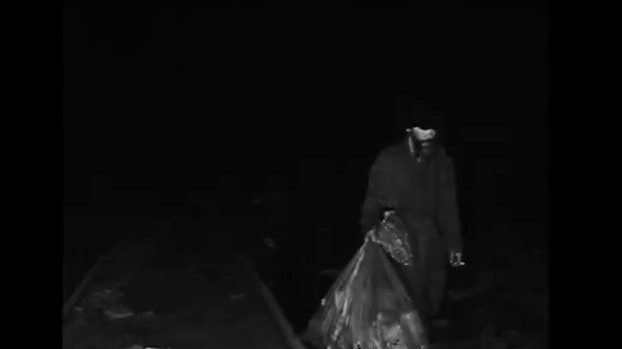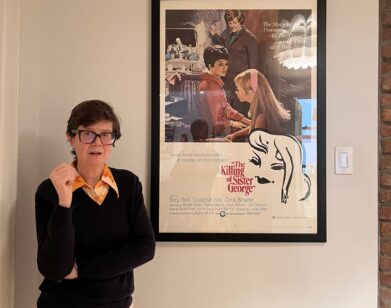Marc Singer After Dark

Urban myths abound in New York, particularly in its underground: alligators swim in the sewers; “mole people” inhabi the subway tunnels; announcements claim, “this train will be moving momentarily.” While the first and last are unlikely, the second is proven true in the powerful documentary Dark Days, which opens today in re-release in New York. Dark Days sheds light on the denizens of the Amtrak tunnel near Penn Station in 1994 and provides a fascinating glimpse of a parallel world beneath the streets. With tunnel wall graffiti, graf-tag titles and a soundtrack mixed by DJ Shadow, Dark Days has fittingly been re-released by hip-hop pioneer/Beastie Boy Adam Yauch’s Oscilloscope Laboratories.
One of the tunnel’s inhabitants claims that 80% of the dwellers are crack-addicted. And the film depicts people in denial (“When I’m good and ready, I’m gonna stop”). Dee, a woman whose hut is set ablaze because “she did somebody wrong,” ruefully mourns the loss of her children (“I miss the responsibility of being a mother”), while in another scene, she relentlessly re-lights a crack pipe. Nonetheless, the alternately disturbing and life-affirming portraits testify to the remarkable ability of the human spirit to adapt. Most of the tunnel dwellers are articulate and often contemplative in their interviews. Many of their wooden shacks look almost cozy. They groom, shave, and bathe with pitchers of water or under leaky pipes. They survive by foraging for “perfectly fresh” food in garbage bags behind restaurants, or for discarded items (CDs, magazines, appliances) they resell, or bottles redeemable for deposit. From discussing the fine points of a cornbread recipe to playing with their dogs or hanging with friends, the residents are human—not stereotypes of the homeless.
The film’s intimacy—which never editorializes or preaches—is the result of the first-time filmmaker’s actually living among the tunnel’s residents. British filmmaker Marc Singer was 20 years old and living in an East Village apartment when he found himself drawn to the homeless. Singer’s own story is the most intriguing to emerge from the subterranean depths: without any money for equipment or film, or any filmmaking education whatsoever, Singer made Dark Days, which in 2000 won three awards at Sundance (including the Audience Award), one at SXSW, and the Independent Spirit and L.A. Film Critics awards for Best Documentary. After his highly acclaimed debut, the utterly free-spirited Marc Singer walked away from filmmaking. We had a rare interview with Singer on the eve of Dark Days‘ re-release.
LORRAINE CWELICH: What compelled you to make Dark Days?
MARC SINGER: I was already living in the tunnel for about three months, just helping people, and I’d made a lot of friends. I loved being there. One night we were sitting around the fire, there was a pretty good group, and we were laughing and Ralph, one of the guys, said, ‘”Man, somebody should be making a film about this stuff.” So I said, “Why don’t we do it?” If we made any money, it would get everybody out of the tunnel. At the same, they’d be the whole film crew. That way, they’d be getting themselves out of the tunnel, as well. But it was never my intention to be a filmmaker. It was the right timing, at the right place.
CWELICH: How did you come to live in the tunnel?
SINGER: I still had an apartment at that point, for the first few months. Then there were a few months of “How do I get a camera? How do I load the camera? Where do I get film?” We built a dolly ourselves, which ran on the abandoned tracks, and that whole process took a few months.
CWELICH: So you gave up your apartment and moved into the tunnel full-time?
SINGER: I needed money to buy film, so I started selling stuff in my apartment—books, CDs, my telephone, bed. And there was a massive amount of kindness from strangers—the camera house, Kodak, the editing facility; everybody pitched in.
CWELICH: You hadn’t gone to film school at all?
SINGER: I thought, it can’t be that difficult. I mean, anyone can do anything. Hopefully this film proved that, not just for myself, but for all the guys who were the crew on the film. I did read some film books once we started.
CWELICH: What drew you to find the people living in the tunnel?
SINGER: I was living around the corner from Tompkins Square Park, and in 1993, there were a lot more people living on the street. I’d see the same people every day, coming home, and they’re in your neighborhood and you say hello and started making friends. They fascinated me: what was it like to be homeless? So I started to hang around with more homeless people and learn and make friends and help people out and just talk. I met a guy named John Murphy, who was an amazing poet but he also had a pretty big heroin addiction. I probably spent about three months hanging out with him every day and once asked John, “If you could live anywhere on the street, where would you live?” He would always talk about the tunnels. He said you could build a house down there, it’s a much better than living on the streets, but he was also afraid because there’s a big mythology surrounding the tunnels. There’s a lot of rumors, and your imagination can run wild. But I was fascinated and began exploring different tunnels. I spent about a month going in and out of many, many tunnels under the city. I ended up finding the Amtrak tunnel.
CWELICH: How many people were living there, and why did you choose the Amtrak tunnel?
SINGER: In the winter, there was a core group of 50-75 people. In the summer, that number would go up dramatically, 100-150. There’s a lot more people living on the street in the summer, it’s easier to sleep outside, more kids run away in the summer. There were probably thousands living in the subway tunnels at that time, but it came rapidly to an end because the MTA really started clamping down on it. It’s dangerous in subway tunnels, less so in the Amtrak tunnel. In the subways, there’s the third rail, and trains move every few minutes rather than every few hours. I found that the people I met were nothing like what I expected them to be like, the preconceived ideas of what a homeless person is like.
CWELICH: How were they different from your preconceptions?
SINGER: Homelessness is usually lumped into one big mass. Everyone’s individual: you’ve got guys that are really nice, gals that are sweet and lovely; people who are not very nice; people on drugs and people completely clean and sober; you’ve got young, old, black, white, everyone. The only difference between them and me was that they didn’t have a place to live. Everything else that you feel in a day—your emotions, your hopes and dreams, the girl you like down the street, the one that got away, what you’re going to eat for dinner, problems with money—whether you pick up empty cans or work on Wall Street, it’s basically the same issues. After living there, I felt that our preconceptions that they were dangerous or crazy stemmed from fear or the desire not to get involved. To be homeless, you have to be extremely courageous and ingenious just to survive.
CWELICH: Once you were out of the tunnel and the film was released, what happened next?
SINGER: The film went to Sundance, and after that, I was traveling for a long time. I was staying with a lot of different friends and finally got an apartment about a year later. I went scuba-diving for a long time and I worked with groups in Florida called Global Underwater Explorers and the Woodville Karst Plain Project for a few years. They’re two organizations that are dedicated to water conservation and protection, and they’re on the cutting edge of technical diving.
CWELICH: Did you consider making another film?
SINGER: I started another film about a team of Marine Corps Special Forces, but I didn’t finish it. I don’t know if I’ll ever make another film again. I’d only want to make another film with my own money. If I made a film about you, and you trust me and let me in and expose your strengths and weaknesses and I’m there for an amazing time in your life or a devastating time in your life—I have this footage and you trust me to be responsible to respect the process that we’ve gone through. If I’m paying for the movie, I can honor that, but if someone else is paying for it, they have a target audience and ratings and say, “We need to see more of this or that,” it wouldn’t be a true representation of you. A documentary has a massive responsibility for portraying people’s lives truthfully.
DARK DAYS OPENS JULY 1 AT CINEMA VILLAGE IN NEW YORK AND IS AVAILABLE ON DVD JULY 19 VIA AMAZON AND OSCILLOSCOPE.






